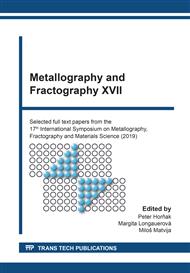p.365
p.373
p.379
p.385
p.391
p.396
p.402
p.411
p.417
Influence of Oxide Dispersoids on the Structure Development of Copper Nanocomposite Prepared by Spark Plasma Sintering Technology
Abstract:
Dispersion strengthened Cu composites are studied over recent years to find an optimum processing route to obtain a high strength, thermal-stable copper alloy designed for modern applications in electrical engineering. The experimental Cu–4Al2O3–1MgO material was prepared by in situ thermo-chemical technique and mechanical milling followed by spark plasma sintering (SPS). The study analyses the influence of the Al2O3 and MgO secondary phases on strengthening the copper matrix. Microstructure of the composite was studied by X-ray diffraction analysis, scanning and transmission electron microscopy. The sintered microstructure shows a grain size distribution characterized by ultrafine grains/twins embedded inside the matrix of nanocrystalline grains. The microstructure is thermal stable up to 900 °C due to the dispersed alumina nano-particles that effectively strengthen crystallite/grain boundaries during the SPS process and annealing of the sintered compact at elevated temperatures. On the other hand, the coarsened MgO particles are responsible for ultrafine grains/twins formation. The obtained microstructure is important for practical utilization of the material because this structure is characterized by a good combination of strength and ductility.
Info:
Periodical:
Pages:
391-395
Citation:
Online since:
November 2020
Authors:
Price:
Сopyright:
© 2020 Trans Tech Publications Ltd. All Rights Reserved
Share:
Citation:


